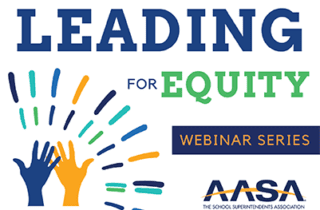Even before the COVID-19 pandemic led to changes in the traditional education model, there was widespread recognition that schools alone could not do everything needed to provide an equitable education for diverse students because so many factors that determine students’ success were being affected or determined outside of school.
With so many issues for school and district leaders to deal with during this difficult time, staying focused on students’ learning experiences may not always seem like the top priority. But district officials from Alabama and Minnesota, who are determined to provide an equitable education for all their students, recently explained how listening to students and taking action based on student input is a key factor in achieving successful outcomes.
These and other important lessons from Oregon’s Gresham-Barlow School District were discussed during a recent edWebinar, hosted by AASA, The Superintendents Association and AASA’s Leadership Network, with the district’s Superintendent, Dr. Katrise Perera, and Assistant Superintendent of Curriculum, Instruction, and Assessment, Lisa Riggs. Gresham-Barlow’s school leaders explained how they have been able to increase and sustain engagement in district activities, and how this has led to improved outcomes for the students.
Now that the 2020-21 school year is underway, district leaders must continue to respond in new ways to fast-changing situations resulting not just from COVID-19, but also from equity issues, and in many locations from environmental problems as well.
Large school districts in different parts of the United States have now developed systematic ways to increase diverse students’ access to advanced courses, and the districts are also providing other important aspects of an equitable education that prepares the students for 21st century careers.
While gaps in technology access were highlighted during the pandemic, many school and district leaders are trying to make strides with an even older issue: educational equity for children of all races and economic backgrounds. In the edWebinar, “Leading for Equity: Pursuing an Equity Agenda,” hosted by AASA, The Superintendents Association and AASA’s Leadership Network, Dr. Frank Barnes, Chief Equity and Accountability Officer, Charlotte-Mecklenburg Schools (CMS), and Kimberly Vaught, Principal, Allenbrook Elementary School, discussed their approach to building equity.
Achieving educational equity doesn’t just happen when schools change their expectations and goals in the classroom. Support and understanding from all stakeholders, including families, local businesses, elected officials, etc., is essential to ensuring everyone in the community is working towards the same goal. During the edWebinar, “Leading for Equity: From Research to Practice – Accelerating Outcomes for Scholars of Color, Part II,” hosted by AASA, The Superintendents Association and AASA’s Leadership Network, the presenters continued their exploration of strategies discussed in Part I and how leaders in the Selma City Public Schools are mobilizing their community in pursuit of educational equity.
Achieving educational equity is a moral and fiscal imperative, according to Dr. Bren Elliott, Chief School Improvement and Supports Officer for District of Columbia Public Schools. Moral because all students deserve access to the same high-quality education and opportunities, and fiscal because research shows the negative economic impact when students are left behind. In the edWebinar, “Leading for Equity: From Research to Practice – Accelerating Outcomes for Scholars of Color, Part I,” hosted by AASA, The Superintendents Association and AASA’s Leadership Network, the leaders from Selma City Public Schools in Alabama shared the first part of their plan and how it ties into Dr. Elliott’s research on successful strategies for achieving educational equity.
Join this edWebinar to recognize the importance of hiring and retaining the right person to maintain stability for the program, families, and children.
The goal of this edWebinar is to help educators start the work of equitable practices through more access, choice, and time—encouraging all students to be seen and heard while having multiple opportunities for biased free learning.





